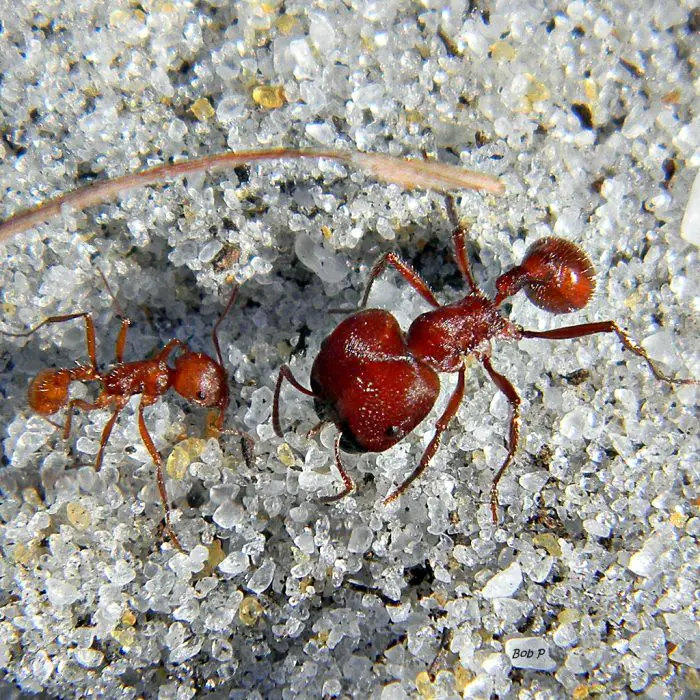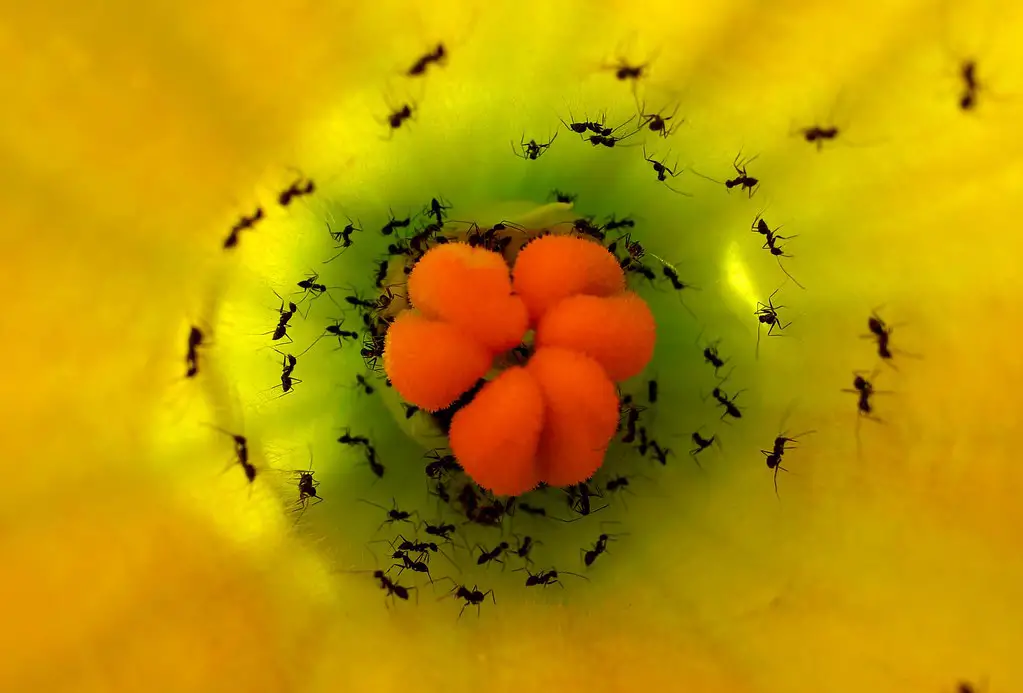Venture into the intricate realm of harvester ants within our urban tapestry. These discreet creatures have masterfully adapted to urban settings, unveiling their exceptional tenacity.
Flourishing under sidewalks and roads, harvester ants emerge as urban pioneers. Their diet, centered on collecting minuscule food fragments, hones their skills for navigating the urban maze.
Confronting scarcity, harvester ants unveil a distinctive survival approach. They fine-tune activity, achieving equilibrium between exploration and repose. This precision ensures survival even amid the harshest of odds.
Interestingly, these ants exhibit a social dance of cooperation. Amid plenty, they unite for food-gathering synergy. In scarcity, unity endures. They share resources, cementing colony survival.
Harvester ants epitomize adaptation and fortitude. They beckon us to recognize the contributions of these modest dwellers in the urban weave. Amid bustling lives, honoring harvester ants and their role in upholding nature’s equilibrium becomes imperative.
What Do Harvester Ant Looks Like?
Harvester ants also known as Pogonomyrmex spp are distinguishable by their unique features:
- Appearance: These ants are generally medium to large in size, ranging from 4 to 10 mm. They have a robust build and often exhibit a combination of red, orange, brown, or black colors, depending on the species and region.
- Head and Thorax: These ants possess a distinct head and thorax separation, with a noticeable constriction between the two body parts.
- Mandibles: Their mandibles, located at the front of their heads, are formidable and adapted for cutting and carrying seeds.
- Antennae: They have 12-segmented antennae that aid in sensory perception and communication within the colony.
- Abdomen: Their abdomens are rounded and relatively large, which allows them to store the seeds they collect for sustenance.
Overall, harvester ants’ appearance reflects their specialization in seed collection and foraging. Keep in mind that variations in size and color can occur due to factors like species and environment.
Distinctive Traits of Harvester Ants
Red Harvester Ants

Are you curious about the striking red harvester ants? These ants, with their vibrant red coloration, are known for their distinct appearance. Their large size, ranging from 4 to 7 mm, sets them apart.
They are characterized by their strong mandibles and rounded abdomens, which they use to collect and store seeds. Their presence often indicates an active role in seed dispersal, contributing to the ecosystem’s balance.
Black Harvester Ant
Have you encountered the enigmatic black harvester ants? These ants sport a unique and sleek black appearance, standing out from their counterparts. With sizes ranging from 5 to 10 mm, they exhibit a robust build.
Their distinguishing feature lies in their contrasting dark coloration, often accompanied by reddish-brown highlights. Black harvester ants are proficient seed gatherers, showcasing their vital role in maintaining local plant populations.
Maricopa Harvester Ant
Interested in the Maricopa harvester ant, a desert dweller with distinctive traits?
These ants, measuring about 5 to 7 mm, display a remarkable combination of red and black colors. They’re recognized by their reddish-brown head and thorax, along with a black abdomen.
These ants are skilled foragers, playing a pivotal role in desert ecosystems by collecting and distributing seeds. Their presence highlights their crucial contribution to the arid landscape’s vitality.
Remember, these ants’ appearances vary based on factors such as species and geographic location, adding to the diversity of our natural world.
What Do Harvester Ants Eat?
Ever wondered about the culinary preferences of harvester ants? What’s on their menu? Let’s dive into their dining habits.
- Seeds, the Ultimate Delicacy
They have a distinctive appetite for seeds. These tiny foragers are experts at collecting and storing seeds, making them a key player in plant dispersal.
- Sweet Temptations
Beyond seeds, these ants have a sweet tooth. They relish sugary substances like nectar, honeydew, and the excretions of aphids.
- Nature’s Harvesters
Their diet not only sustains them but also contributes to the ecosystem. By collecting seeds and aiding in pollination, they play a vital role in maintaining the balance of their habitat.
- A Balanced Diet for Survival
From seeds to sugary treats, they have a well-rounded diet that ensures their colony’s survival and success.
Where Are Harvester Ants Found?
Curious about the domains where harvester ants reign? These industrious insects have adapted to a wide range of habitats:
- Desert Dwellers
Harvester ants are often associated with arid landscapes like deserts. Their robust nature enables them to thrive in these challenging environments.
- Grasslands and Savannas
You’ll also find These ants in grasslands and savannas. Their seed-gathering skills make them a crucial player in these open ecosystems.
- Sandy Soils
These ants prefer sandy or loose soils, which are ideal for their nest construction and seed storage.
- Geographical Diversity
Harvester ants are spread across North and South America, showcasing their adaptability to various climates and regions.
From the sun-soaked deserts to the vast grasslands, they have carved their niche in diverse habitats, showcasing their ability to thrive in different corners of the world.
Harvester ants bite
Ever wondered about the defensive capabilities of harvester ants? Do these tiny creatures possess a bite to fend off intruders?
Let’s delve into their defensive strategy.
Bite for Protection
Yes, harvester ants do indeed have a bite. When they feel threatened or their nests are disturbed, they can employ their powerful mandibles to deliver a defensive bite.
Minor Discomfort
While their bites are generally not harmful to humans, they can cause discomfort and slight pain. It’s their way of safeguarding themselves and their colony from potential dangers.
A Natural Defense Mechanism
Much like other creatures, harvester ants use their bites as a first line of defense, highlighting their resourcefulness in the face of adversity.
So, the next time you encounter these ants, remember that their bites are a testament to their determination to protect their nest and ensure their survival.
How To Get Rid Of Harvester Ants?
Tired of sharing your space with harvester ants? Ready to bid them farewell? Let’s explore effective strategies to manage their presence:
- Identify the Source:
First things first, locate their nests. Tracking down where they’re coming from will help you focus your efforts.
- Eliminate Food Sources:
Cut off their supply. Ensure no crumbs or food particles are accessible to these ants. Cleanliness is key.
- Natural Repellents:
Mother Nature has solutions. Peppermint oil, cinnamon, or diatomaceous earth can deter them effectively.
- Bait and Switch:
Bait traps with non-toxic ant baits. They’ll carry it to their colony, disrupting their population.
- Seal Entry Points:
Block their entry. Caulk cracks and crevices to deny them access to your space.
- Professional Assistance:
If the situation escalates, don’t hesitate to call pest control experts for targeted solutions.
- Consistency Wins:
Persistence is key. Keep up with your chosen strategy until you notice a decline in their activity.
With these steps, you’re on your way to reclaiming your space from harvester ants. Ready to bid them adieu for good? Your ant-free environment awaits.
Conclusion
In the intricate world of harvester ants, their tenacity shines as they adapt to urban landscapes. These resourceful creatures master the balance between bustling city life and their innate instincts.
From their diet of seeds and sweet indulgences to their diverse habitats in deserts and grasslands, harvester ants leave an indelible mark. Their defensive bites reflect their determination to safeguard their colonies.
Effective strategies to manage their presence empower us to coexist harmoniously. As we bid farewell to these fascinating insects, let’s embrace the harmony they exemplify and honor their role in the intricate tapestry of nature.



